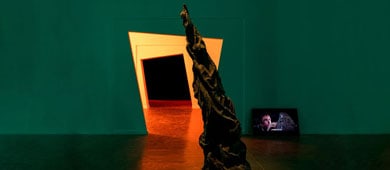Vividus
Curator: Bar Yerushalmi
30/01/2020 -
26/09/2020

Light design: Yoav Barel
Sound design: Binya Reches
Graphic design: Ayal Zakin & Tali Liberman
Some ten years ago Israeli scientists succeeded in germinating a 2000-year-old date palm seed of an extinct species recovered at an archaeological excavation in Masada. The tree, nicknamed Methuselah (after the biblical character reported to have lived the longest), now thrives in Kibbutz Ketura in the Arava, a living testimony to a life that had passed from the world. Beyond a revolutionary scientific discovery, the Methuselah case is a conceptual as well as a physical illustration of the mythology of resurrection—the possibility that something long extinct or dormant, would reenter the cycle of life.
The return to life, heretofore reserved to necromancers or science fiction fans, becomes the subject of a possible evolution for any biological or social form of life striving to survive vis-à-vis external forces that threaten to eradicate it. The possibility of resurrection blurs the line between that which is alive and that which is not. At the same time, however, it embodies the concept of the Last Judgment, when the dead will join the living, and yesterday will become an integral and active part of the present.
The exhibition explores the principle of resurrection as a survival tactic for the work of art. It strives to shed new light on the museum collection and imagine it as a living fossil: a biological-cultural form of life that sustains its past and present concurrently; a mode of life that conceals systems for regulation and preservation of visual human history.
Entering the exhibition is like entering a fictive multicellular organism where each room operates as an independent organ with a distinct function, and together they form a single organic entity. The featured works—the organism’s constituent elements—were all selected from the museum’s art collection, reflecting the unique historical strata in the life cycle of the collected corpus: since its beginnings as a collection of commemorative and memorial works for the fallen soldiers to the introduction of contemporary works from recent decades. As independent units of life, they move in fixed clusters along the temporal axis between growth and withering, awakening to temporary life by the touch of light.
Bar Yerushalmi, Curator of the Exhibition

